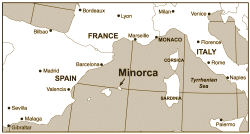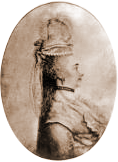Origin and demise
The New Smyrna settlement was the product of British attempts to populate Florida with colonists who would benefit the Crown. Britain had obtained Florida and the Mediterranean island of Minorca from Spain in 1763, following a global war involving several European powers. She quickly divided her new possession into two administrative districts - East and West Florida - with the Apalachicola River as the dividing line. St. Augustine became the capital of East Florida and James Grant was appointed governor.

Britain's desire to colonize Florida was spurred by the need to offset her costly dependence on imported commodities such as indigo, silk, cotton, rice, cochineal, wine, and oil. To encourage agricultural development, land grants were offered to prospective plantation owners at easy terms, and financial rewards were bestowed if planters grew cash crops for export to England.
Dr. Andrew Turnbull, a Scottish-born physician and wealthy member of London society, was one who accepted the challenge. Turnbull and Sir William Duncan were awarded grants of 20,000 acres each and, together with Sir Richard Temple, the three partners provided the capital necessary to develop a large plantation in Florida. Turnbull was chosen as plantation manager. His first task was to travel to East Florida to choose a location for the plantation settlement and begin preparing for the colonists. On his return to England, Turnbull began finding capable laborers to work on the plantation.

For workers he turned to the island of Minorca, where a three-year crop failure had left many farmers destitute. He was able to recruit about 1,100 Minorcans as indentured servants and added 200 more laborers from Greece and about 100 from Italy, France, Corsica, and Turkey.
On April 17, 1768, Turnbull assembled his 1,403 colonists at Gibraltar and, after loading them onto eight ships, set sail for East Florida. The voyage took nearly four months. Hardships at sea, particularly scurvy and infections, took their toll in lives. When the ships reached New Smyrna in August, the number of colonists had been reduced to 1,255. To make matters worse, housing and accommodations were in place for only about 500. Palm huts were quickly constructed to provide temporary shelter, but were still being used by some of the colonists a year after their arrival.
The colony experienced a cycle of bad and good years during its short history. While at first the colonists suffered many deaths from ill health and poor nutrition, they managed to clear and plant agricultural fields, erect additional housing, and assist in the construction of a plantation infrastructure. The good years, 1771-1773, were characterized by a fall in the death rate, an increase in agricultural crop yields, and a somewhat stabilized lifestyle. Bad years began again with severe droughts in 1773 and 1775. With crop yields down, the colonists went hungry and in 1774, the death rate began to climb again.
Although weather conditions improved after 1775 and crop yields rebounded, the colonists' discontent increased. There was a growing concern that Turnbull would never honor the contracts under which the colonists had agreed to come to Florida. The colonists also resented their overseers, many of whom had previously worked black slaves. The mix of ethnic groups, with their different languages and customs, as well as problems with Indians, also made matters desperate. Finally, Turnbull's inability to produce marketable crops in quantities large enough to satisfy his investors cost him their support, as well as that of the British government. The end of the New Smyrna colony came in 1777 when the plantation was virtually abandoned by most of the surviving colonists who fled to the safety and security of St. Augustine.

Turnbull raised cattle and grew rice, corn, sugar, hemp, cochineal (a native parasite of the prickly pear cactus that was used to manufacture a red dye), and cotton. But his primary agricultural focus was indigo (Indigofera suffruticosa). Considered "the king of dyestuffs," the brilliant blue dye commanded a high price in Europe. Indigo was profitable only on large plantations, such as New Smyrna, because expensive equipment was required for its production. After the plant was harvested, it was placed in a tiered vat system that was used to steep and ferment the vegetation and extract the dye. The rotting vegetation smelled so hideous that even buzzards refused to frequent the area around an indigo vat. The dye was then poured off, allowed to dry, and cut into bricks for shipment to England.
Many buildings were constructed during the nine-year existence of the colony, including houses and support structures for the colonists, slaves, and overseers, workshops, storehouses, a church, wharves, and agricultural buildings. These extended from Spruce Creek south into the modern community of Edgewater. The central core of the settlement was located in what is now part of downtown New Smyrna Beach. Early maps show the King's Road, an official highway that connected St. Augustine with New Smyrna, ending near the present downtown area. Turnbull's own house was believed to be located at the north end of New Smyrna Beach near Spruce Creek, on his personal 300-acre grant.

The New Smyrna colony was named for the birthplace of Andrew Turnbull's wife, Gracia Maria Rubini, who was born in Smyrna, Asia Minor, in 1736. Said to be of Greek descent, Gracia was educated in Paris where she met Turnbull who was there studying medicine. The two were married in 1753 and Gracia eventually gave birth to 12 children. Both Turnbull and his wife died in Charleston, South Carolina, Turnbull sometime between 1786 and 1788, his wife in 1798.

